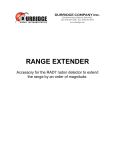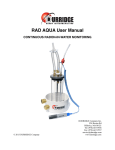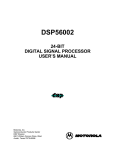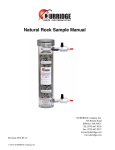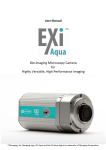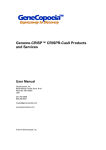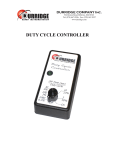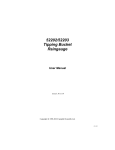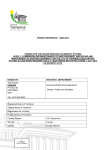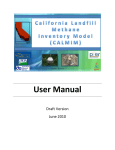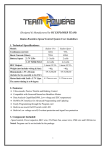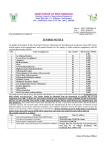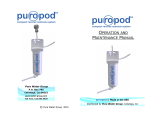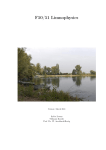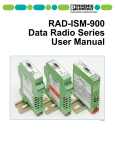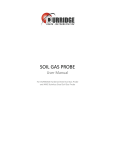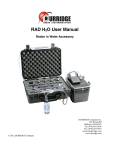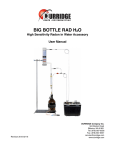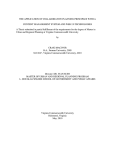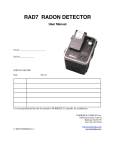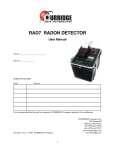Download RAD AQUA Manual 2015-03-06
Transcript
RAD AQUA Continuous Radon-in-Water Accessory for the RAD7 User Manual Revision 2015-03-06 DURRIDGE Company Inc. 524 Boston Road Billerica, MA 01821 Tel: (978) 667-9556 Fax: (978) 667-9557 [email protected] www.durridge.com TABLE OF CONTENTS INTRODUCTION! 5 1. RAD AQUA SETUP! 6 1.1 EXCHANGER ASSEMBLY! 1.1.1 Nozzles! 1.1.2 Temperature Probe! 1.1.3 Air return! Fig. 1 RAD AQUA with Temperature Probe! 1.1.4 Tie rod! 6 6 6 6 6 7 1.2 CONNECTIONS! 1.2.1 Air loop! Fig. 2 RAD7 AQUA Standard Setup! 1.2.2 DRYSTIK! 1.2.3 RAD7 and Exchanger Location! 1.2.4 Water Supply ! 1.2.5 Temperature Probe! 7 7 7 8 8 8 8 1.3 WATER FLOW! 1.3.1 Water Source! 1.3.2. Water Level! 8 8 8 1.4 AIR FLOW! 1.4.1 Continuous Pumping! 1.4.2 Pump on “Auto”! 1.4.3 Mode set to “Auto”! 9 9 9 9 1.5. PROTOCOL! 1.5.1 RAD7 Protocol! 1.5.2 RAD AQUA Protocol! 1.5.3 User Protocol! 9 9 9 9 2. MEASUREMENT PROCEDURE! 10 2.1 START UP! 2.1.1 Temperature Probe! 2.1.2 Start Measurement! 10 10 10 2.2 SPEED OF RESPONSE! 2.2.1 Measurement in Progress! 2.2.2 Influencing Factors! 2.2.3 Water flow rate! 2.2.4 Air flow rate! 2.2.5 RAD7 Mode! 10 10 10 10 11 11 2 © 2015 DURRIDGE Company Inc. 2.3 Long Term Measurement ! 2.3.1 Desiccant! 2.3.2 Memory ! 3. DATA! 11 11 11 12 3.1 DATA HANDLING! 3.1.1 Printer! 3.1.2 Memory ! 3.1.3 RADLINK! 3.1.4 CAPTURE for Windows or Mac! 3.1.5 Temperature Data! 3.1.6 Time Relationship! 12 12 12 12 12 12 12 3.2 DATA CONVERSION! 3.2.1 FRITZ WEIGEL! 3.2.2 CALCULATION! 13 13 13 4. THORON in WATER! 14 4.1 Why Thoron?! 14 4.2 Measurement in Water! 14 4.3 Thoron Sensitivity! 4.3.1 Source to Exchanger! 4.3.2 Exchanger to RAD7 method 1! 4.3.3 Exchanger to RAD7 method 2! 14 14 14 14 4.4 Speed of Response! 15 5. DRYSTIK! 16 5.1 Passive DRYSTIK! 16 5.2 Active DRYSTIK! 16 5.3 Effect on Response Time ! 16 5.4 Custom designed Active DRYSTIK! 16 Fig. 3 RAD AQUA configuration with Active DRYSTIK and Water Switch! 17 6. BOATING! 18 6.1 Response time ! 6.1.1 Minimizing T1 with increased water flow rate! 6.1.2 Minimizing T1 with reduced air volume! 6.1.3 Minimizing T2 with a higher sensitivity RAD7! 6.1.4 Minimizing T2 with multiple RAD7s and one RAD AQUA! 6.1.5 Minimizing T2 with multiple RAD7s and multiple RAD AQUAs! 3 © 2015 DURRIDGE Company Inc. 18 18 18 18 19 19 6.2 Pump position! 6.2.1 Positioning Equipment! 7. CARE, MAINTENANCE, and TROUBLESHOOTING! 19 19 20 7.1 WATER CATASTROPHE! 20 7.2 RAD7 CARE! 20 7.3 EXCHANGER CARE! 20 7.4 DESICCANT REGENERATION! 20 7.5 RAD AQUA TROUBLESHOOTING! 7.5.1 Rising Water Level! 7.5.2 Spray Chamber Fills With Water! 7.5.3 Air Path Integrity ! 7.5.4 Poor Spray Formation! 7.5.5 Water Overflowing From Base! 21 21 21 21 21 21 References and Bibliography! 4 © 2015 DURRIDGE Company Inc. 22 Introduction INTRODUCTION The RAD AQUA is an accessory for the DURRIDGE RAD7 Electronic Radon Detector. It is a device to bring the radon concentration in a closed air loop into equilibrium with the radon concentration in a flowthrough water supply. It consists of a spray chamber, called an “exchanger”, that brings the air and water into equilibrium. The radon in the air is monitored continuously by the RAD7. The partition coefficient, the ratio of radon concentration in the water to that in the air at equilibrium, is determined by the temperature at the air/water interface. This temperature is measured with a temperature probe inserted into the exchanger. At typical room temperature the coefficient is about 0.25. That means there is four times higher concentration of radon in the air than in the water, so there is, in effect, a gain of four times in the sensitivity of the system to radon in water, compared to radon in air. It takes time for the water to deliver radon to the air loop and for the RAD7 to respond to the changed radon concentration. With optimum configuration the response time of the system may be reduced to less than half an hour. CAUTION Tap water and typical ocean water have sufficient dissolved gases to maintain the water level in the exchanger at an acceptable level. However, should the water level in the exchanger start to rise to an unacceptable height an air bleed may be added as described in Section 7. This will prevent water from being drawn into the desiccant and hence into the RAD7. 5 © 2015 DURRIDGE Company Inc. 1. RAD AQUA Setup 1. RAD AQUA SETUP 1.1 EXCHANGER ASSEMBLY The RAD AQUA exchanger is supplied semiassembled. First the chosen nozzles and other components should be installed in the head assembly then the base, trivet, cylinder, rod and head should be assembled together and held in place with the brass thumb screw. 1.1.1 Nozzles The RAD AQUA is supplied with three pairs of alternative nozzles. These are the WL4, WL1 and WL0.25. We install one and include the other two in the accessories. At 20psi (138 Pascal) water pressure the published flow rates for each are: WL4 WL1 WL0.25 - 10.98 L/min. 4.1L/min 0.68L/min. WL0.25 is intended for slow continuous monitoring where rapid changes are not expected and where conservation of water is a consideration. WL4 is intended for those applications where speed of response is a major goal. WL1 is a compromise between the two. 1.1.2 Temperature Probe The probe is inserted through the stem adapter. A little petroleum jelly may help it to slide into position. Fig. 1 RAD AQUA with Temperature Probe 1.1.3 Air return The air return is sent, via the check valve, to the internal tubing that terminates halfway down the cylinder. The actual length of that internal tubing is not critical. If it is very short air would be able to short-circuit the exchanger without passing through the spray. If it were too long it may terminate beneath the internal water surface and may lose air through the water outlet. It should be about halfway down the cylinder. 6 © 2015 DURRIDGE Company Inc. 1. RAD AQUA Setup 1.1.4 Tie rod feet between the exchanger and the RAD7. Insert one end of the tie rod into the thread in the trivet. Place the cylinder in the trivet slots. Push the head assembly onto the rod. Attach and tighten the thumb screw to draw and hold the assembly together. Connect the OUTLET of the RAD7 to the checkvalve connected to the head assembly. For this, the 5ft long, 3/16" ID tubing, with a 1/8" ID section at one end, may be used. The 1/8" end fits on the RAD7 outlet, and the 3/16" end fits the check valve. Connect the other 3/16” hose connector on the head assembly to the laboratory drying unit, at the SCREW CAP end, with the tubing and sleeve provided. 1.2 CONNECTIONS 1.2.1 Air loop Two pieces of tubing connect the RAD7 and drying unit to the RAD AQUA air/water exchanger, as shown in Fig. 2. These two pieces of tubing can be several tens of meters long. The standard tubing supplied with the RAD7/RAD AQUA is sufficient for a connection up to five Connect the other end of the laboratory drying unit (there should be at least one inch of blue desiccant left at this end) to the air inlet filter (with 1/8" ID tubing at the filter end), which is then placed on the RAD7 INLET. The Luer taper ensures an airtight connection. Fig. 2 RAD7 AQUA Standard Setup 7 © 2015 DURRIDGE Company Inc. 1. RAD AQUA Setup 1.2.2 DRYSTIK 1.2.5 Temperature Probe Please note that the above instructions are for use of the RAD AQUA without a DRYSTIK humidity exchanger. A DRYSTIK, if available, should be placed between the exchanger and the drying unit, and the outer sheath should be purged with dry air from the RAD7 outlet. See Fig. 3 in Section 5. More details are provided in the DRYSTIK user’s manual. The temperature probe should be inserted down the stem adapter as far as it will go. A little Vaseline smeared on the shaft will help it go in more easily, and will also ensure an air-tight fitting. The probe should be plugged into the temperature data logger, which should be put in its own plastic bag to protect it, once it has been launched. 1.2.3 RAD7 and Exchanger Location 1.3 WATER FLOW Place the RAD7 on a clean, dry surface, preferably inside a laboratory. If it has to be located in a harsh environment, then it should be protected from the elements (especially water). A simple way to do this is to place the RAD7 inside a large transparent plastic bag, such as the one in which it was originally shipped. The bag opening should be gathered around the inlet and outlet tubes, so that the instrument is inside a closed space, completely protected from the elements, while still allowing observation of the LCD and print-out, and operation of the key pad. 1.3.1 Water Source The exchanger unit may be placed upright in a sink, or higher than a boat’s gunwales. Water will flow from the hose outlet, in the base of the exchanger. A garden hose may be connected to the exchanger base, to take the outflow, provided it runs downhill from the exchanger. 1.2.4 Water Supply The water supply should be connected to the two large hose connectors in the head assembly. If the supply will be at high pressure, then clamps may be necessary around the water tubing, to hold the tubes on. For a slow-response application, where water conservation is important, one nozzle can be sealed with a cap over the hose connector and water supplied only to the other one. 8 The water entering the instrument should come direct from the sampling point, below the surface, and should not have been exposed to any airwater interface en route. The water should be clean and free from debris. If necessary, it should be filtered (but not with charcoal) before entering the exchanger. The preferred delivery system is a submerged pump, delivering the water at fairly low pressure, straight from the sampling point to the exchanger. Three sizes of spray nozzle are supplied. The choice will depend on the pump performance and the speed of response required. 1.3.2. Water Level With the water flowing, a spray will be observed inside the body of the exchanger. Water will accumulate inside the base and overflow out through the hose connector(s). If the flow rate is very high it may be necessary to utilize both hose connectors. The level may also start to rise too high inside the body of the exchanger. To correct, either reduce the flow rate or purchase the optional 12” cylinder. A high water level inside the exchanger is no problem provided it is no more than 1/3 of the way up the exchanger and is stable. If the water level rises slowly but continuously up the cylinder it will be due to the water source being completely without dissolved air. To correct this a bleed may be added to the return air path from the RAD7. It should be a long piece of tubing open at one end and connected with a T- © 2015 DURRIDGE Company Inc. 1. RAD AQUA Setup connector to the tubing between the head assembly and the check valve. charged condition. 1.5.2 RAD AQUA Protocol 1.4 AIR FLOW Switch on RAD7. Push the MENU key. Go to: 1.4.1 Continuous Pumping If you choose “SETUP PUMP ON [ENTER]” and “SETUP MODE SNIFF [ENTER]”, then the pump will run continuously, regardless of the length of the cycles, or status of the RAD7, and the RAD7 will count only 218-Po decays. In this operational mode, the system will have the fastest response time, but desiccant is quickly hydrated. SETUP CYCLE, push <ENTER>. Set the cycle time required (as discussed above). SETUP RECYCLE to 00, for continuous operation. SETUP MODE: For fast response, with moderate or high radon concentrations, choose SNIFF. For low concentrations, to gain better statistics, choose AUTO. 1.4.2 Pump on “Auto” SETUP THORON: Choose OFF The pump, in auto operation, pumps for five minutes at the beginning of every cycle and then for one minute in every five. The length of each cycle is chosen by the user. Short cycle times will involve more pumping and speed up the response of the instrument, but will consume more desiccant. Longer cycle times will give better statistical precision to the individual readings, and will conserve desiccant and memory space. For rapidly changing concentrations of radon in the water, 10 minute cycles, with the PUMP on AUTO and MODE on SNIFF, may be a suitable compromise, though not giving fastest response. SETUP PUMP: Choose ON or AUTO, depending on choice, see above SETUP TONE: Choose what you like SETUP FORMAT: Choose what you like, but LONG format with short cycle times uses a lot of paper. You will probably not need to use the printer at all, in the field. SETUP UNITS: Your choice SETUP SAVUSER: Push <ENTER>. When it says “Are you sure?” use arrow keys to change response to “Yes” and push <ENTER>. 1.4.3 Mode set to “Auto” For very low concentrations, or when long-term monitoring is desired, long cycle times of an hour or longer, with the PUMP and MODE set to AUTO, may make good sense. 1.5. PROTOCOL 1.5.1 RAD7 Protocol 1.5.3 User Protocol You now have your personalized USER protocol saved. To recall your settings, go to SETUP PROTOCOL USER and push <ENTER>. To make a change, simply display the parameters to be changed, make your changes then, once more, go to SETUP SAVUSER and save them. First, please read the RAD7 manual and learn how to use the instrument for measurement of radon in air. The RAD7 should normally be operated with AC (or, with 12V option, 12V) power applied, to keep the batteries in a fully 9 © 2015 DURRIDGE Company Inc. 2. Measurement Procedure 2. MEASUREMENT PROCEDURE 2.1 START UP 2.2 SPEED OF RESPONSE 2.1.1 Temperature Probe 2.2.1 Measurement in Progress Load the temperature logger software and connect the temperature logger to the PC using the serial cable provided. Configure the logger to take temperature readings at frequent intervals (these may be far more frequent that the RAD7 test cycles.) The instrument is now measuring the radon in the water. With high concentrations and short cycle times, and depending on the air and water flow rates, it will take half an hour or more before there is much of a reading, and maybe fifty minutes before you can rely on the count rate being close to the equilibrium value. After that you need to accumulate sufficient counts for the precision desired. For example, 100 counts would give a reading with a standard deviation of 10%. At very low concentrations, it may take hours, and averaging over many cycles, to reach a sufficiently precise value. Choose the second (external) temperature sensor. Connect the temperature probe to the logger and note that when you hold the probe the indicated temperature rises. When everything is set, begin recording. The logger’s LED may flash periodically. Once the logger has begun running, you may remove the serial cord from both the logger and the PC. Warning! Make sure that previous temperature data has been downloaded before launching the logger. The launching process may erase previous data. If not already done so, insert the probe into the RAD AQUA. 2.2.2 Influencing Factors There are two processes requiring time. One is for the air in the closed loop to approach equilibrium with the water and the other is for the RAD7 to respond to the changed radon concentration in the air loop. The first is primarily controlled by the water flow rate and the second is determined by the half life of the first daughter of radon, namely 218-polonium. 2.1.2 Start Measurement 2.2.3 Water flow rate Start the water flowing. Note that, after a few seconds, water starts to flow out of the outlet hose. Switch on the RAD7 (have the printer switched on if you are using it. The RAD7 will then print a header for the data printout, including a review of the setup, before it gives you a ‘Test’ prompt.) Provided that the RAD7 has been set up properly, see above, at the ‘Test’ prompt, push [ENTER] then the right arrow, to see ‘Test Start’ on the LCD, then push [ENTER] to start the test. At typical room temperature, the equilibrium coefficient for radon in air and water is about 4:1. That is the concentration of radon in air at equilibrium with water will be four times higher than the concentration in the water. If the water were able to give up all its radon to the air it would take four times the air volume just to deliver the radon. In practice the transfer is not complete so we may estimate that ten times the air volume is required. Considering the volume of the RAD7, the drying unit and the RAD AQUA, we can conservatively estimate the volume of the air loop to be of the order 4 litres. Therefore about 40 litres of water 10 © 2015 DURRIDGE Company Inc. 2. Measurement Procedure is needed to deliver the radon to the air loop before it can reach equilibrium. A water flow rate of V L/min will take at least 40/V minutes to deliver the radon. For slow, long-term measurements with long cycle times AUTO mode for the RAD7 is appropriate. The RAD7’s response time will be a couple of hours or so. The RAD AQUA can be running with a low water flow rate and the RAD7 pump can be on AUTO also. 2.2.4 Air flow rate Though important for thoron, see below, the air flow rate is less critical to the radon response time. For maximum speed of response, the air should keep circulating around the loop so that the air in the exchanger is continually being replenished with air from the measurement chamber of the RAD7. Thus the shortfall from equilibrium and hence the efficiency of transfer is maximized. To achieve this the pump may be set to ON, see 1.4.1 and 1.5.2 above. For a more relaxed operation, the pump may be set to AUTO, which will preserve the desiccant and increase the life expectancy of the pump. Air will remain stationary in the RAD AQUA for four minutes before moving to the desiccant where it waits another four minutes before entering the RAD7. While in the RAD AQUA, the stationary air may approach equilibrium with the water thus inhibiting further radon transfer from the water to the air. It will be about 15 to 20 minutes before that parcel of air returns to the RAD AQUA. We can therefore estimate that the response time of the system will be increased by about 20 minutes if the pump is set to AUTO Having the pump on AUTO would normally be associated with having the RAD7 cycle time of 30 minutes or longer. So an extra 15 to 20 minutes on the response time will not be excessive. 2.2.5 RAD7 Mode In AUTO (the default) mode, the RAD7 will automatically switch from SNIFF mode to NORMAL mode after three hours into the run. This is to take advantage of the additional counts provided by the 214-Po decays that will, by then, have approached equilibrium with the (steady) radon concentration in the measurement chamber. 11 For fast response, however, it is essential to force the RAD7 to stay in SNIFF mode (Setup, Mode, Sniff [ENTER]). It will then always count only the 218-Po decays, giving it a 13-minute, 95% response time. 2.3 LONG TERM MEASUREMENT 2.3.1 Desiccant As set up, above, the system will continue making measurements indefinitely. There are, however, various resources that are being used up in the process, and which must be replenished. The most obvious is the desiccant. A new, or regenerated, laboratory drying unit will normally last for about ten days of continuous use in a temperate climate. In this application, however, it is receiving saturated air and, therefore, will be hydrated more quickly. When the remaining length of blue (dry) desiccant is less than one inch, the desiccant should be replaced. Please see the RAD7 manual on desiccant regeneration. If the desiccant is not replaced, and the humidity in the instrument rises above about 20%, then the sensitivity drops off and the reading is lower than the true value. 2.3.2 Memory The capacity of the internal memory of the RAD7 is 1,000 records or cycles. If each cycle is half an hour, that would be data for 500 hours, or just over 20 days. Every time the desiccant is changed, therefore, all the stored data should be downloaded to a PC, backed up, and erased from the RAD7 memory. © 2015 DURRIDGE Company Inc. 3. Data 3. DATA 3.1 DATA HANDLING 3.1.1 Printer The IR printer will print out data in short, medium or long format - see RAD7 manual. In long format, there will be a spectrum printed at the end of every cycle. 3.1.2 Memory The internal memory of the RAD7 stores the date and time, the radon concentration, live time, total count and percentage in each of the main energy windows, as well as a host of other parameters, for every cycle - see RAD7 manual. These data can be downloaded to a PC at any time, during or after a run, with CAPTURE software, supplied. RAD7 data that has been collected using the RAD AQUA should be downloaded using CAPTURE, then graphed using CAPTURE’s RAD AQUA radon source option, which uses water temperature data to calculate radon concentrations. This water temperature data is obtained by exporting it from the temperature logger software, (see Section 3.1.5, below). For specific instructions on downloading and graphing RAD7 data, please refer to the CAPTURE user’s manual, which is available from the DURRIDGE web site. Once the data has been downloaded and backed up securely, you should erase the data on the RAD7, to prevent it from accumulating and filling the device’s memory. 3.1.5 Temperature Data 3.1.3 RADLINK The RADLINK remote control software installed in the RAD7 enables a PC to control the RAD7 remotely, to grab any or all of the data, and to divert what would have been sent to the IR printer to the PC instead - see RAD7 manual. These, as with all other commands, may be invoked from DURRIDGE’s CAPTURE software, as explained below, or using a terminal program that can communicate through the computer’s serial port. The PC must be connected to the RAD7 with a null-modem cable, as supplied with the RAD7. If the PC does not have an RS232 serial port the Keyspan USB/RS232 adaptor, as supplied, should be used. It is advisable to go to the Keyspan web site (<www.keyspan.com>) to download the latest driver for the adaptor and the operating system of the PC. 3.1.4 CAPTURE for Windows or Mac Data recorded to the RAD7 may be easily download and graphed DURRIDGE’s CAPTURE software. CAPTURE is available from the DURRIDGE web site (<www.durridge.com>). 12 To obtain the temperature data, hook up the temperature logger to the PC and run its software to download the data. The program will take a moment to download the entire memory, and then display it as a graph. You should save it to your hard drive before doing anything else. You can also export it to a comma-delineated .TXT file for use with CAPTURE, or for incorporating into a spreadsheet or database program. Warning! Make sure that the data is properly downloaded and backed up before launching the logger again. Certain operations may erase previous data. 3.1.6 Time Relationship A temperature reading is made at the moment in time indicated with the reading. A radon reading, in contrast, is the average value taken over the cycle whose end occurred at the time indicated. More precisely, in SNIFF mode, taking into account the 218-Po half life, a cycle whose end occurred about 5 minutes before the time indicated. For constant radon and temperature values this is of no consequence but if the temperature was changing quickly, then the © 2015 DURRIDGE Company Inc. 3. Data temperature readings during the course of the radon cycle, and for five minutes before, should be averaged to give the average temperature at the air water interface when the radon being measured was leaving the water. 3.2 DATA CONVERSION 3.2.1 FRITZ WEIGEL The RAD7 gives an accurate reading of the radon concentration in the air. With the RAD AQUA, this air reaches equilibrium with the water in the exchanger. To convert the air concentration to water concentration, the air concentration must be multiplied by the partition, or equilibrium, coefficient, given by the Fritz Weigel equation (Weigel, 1978): 3.2.2 CALCULATION The RAD7 radon data is stored in the RAD7 and the water temperature data is stored in the temperature logger. It is necessary to download the RAD7 data to a PC, preferably using DURRIDGE’s CAPTURE software, and to download the temperature logger data using the software provided by the logger’s manufacturer. The water radon concentration may be calculated using CAPTURE (see the RAD AQUA information in the CAPTURE user’s manual) or it may be calculated manually, according to the Fritz Weigel equation. CAPTURE automatically gives the average radon concentration of the selected data between the cursor lines, but the temperature needs to be assessed separately and entered into the equation above to determine the partition ratio. a = 0.105 + 0.405 * exp(-0.0502*T) where T is the temperature in deg C. At room temperature, a is around 0.25, giving, at equilibrium, a four-to-one ratio of radon in air to water. 13 © 2015 DURRIDGE Company Inc. 4.Thoron in Water 4. THORON in WATER 4.1 WHY THORON? 4.3.1 Source to Exchanger Thoron, 220-Rn, an isotope of 222-Rn radon, has a 55.6 second half life. As a result, almost everywhere, it is not to be found. Close to a thoron source, however, the water will still have measurable thoron as it will be still be young and not have had time for it all to have decayed away. The time delay in the water can be made small by having a high water flow rate and a short, small diameter hose. If the hose is no more than 3m long, with an internal diameter of no more than 8mm, say, the hose volume will not exceed 0.15 litre and a water flow rate of, say, 4 L/min will mean a time delay for the thoron to reach the exchanger of no more than 2.5 seconds. Thoron coexists with radon in the soil. Ground water entering the ocean will therefore bring thoron as well as radon with it. Around submarine springs, therefore, there may be thoron in detectable amounts and this may be used to locate the springs (Burnett et al, 2007). 4.2 MEASUREMENT IN WATER Because of its short half-life, the measurement of thoron in water is fraught with difficulties. First, the concentration in the water will vary significantly from point to point and from time to time depending on the position of the sampling point relative to the position of the source and the water flow between the source and the sampling point. Second, during the process of getting the thoron atoms into the measuring device, the thoron will be decaying thus reducing the size of the sample. An estimate of the time taken for this process is required in order to apply a correction to the reading. However, if using thoron as a tracer, a knowledge of the absolute sensitivity is not so important as minimizing the lower limit of detection. This may be done by making the transfer of thoron atoms into the RAD7 as quick as possible. 4.3 THORON SENSITIVITY Sample is lost by decay while in the water en route to the exchanger and then again in the air en route to the RAD7. 14 4.3.2 Exchanger to RAD7 method 1 The RAD7 pump will typically generate an air flow rate of around 0.9 L/min. The volume of the air above the water spray in the chamber will be about 0.5L, the laboratory drying unit is about 1L as is also the RAD7 itself. An estimate, therefore of about 2.5L of air is required to be pumped for a thoron atom in the exchanger to reach the RAD7. At 900ml/min this will take a little less than 3 minutes. The thoron will have decayed through about three half lives between leaving the sampling point and being detected in the RAD7. In addition, the transfer from the water to the air will not be complete and the returning air from the RAD7 will have lost almost all its thoron, so there is another factor to be multiplied in. All in all, we may estimate that we see no more than 10% of what would have been seen had there been no thoron decay during acquisition. 4.3.3 Exchanger to RAD7 method 2 Instead of using the RAD7 pump, a separate pump may be used to circulate air round the loop much faster than the RAD7 pump. However, the RAD7 cannot tolerate an air flow rate higher than 3L per minute. The RAD7, therefore, should be connected to tap into the fast recirculating air loop, using its own pump to do so, with the main air flow bypassing the RAD7. With a circulating air flow rate of, say, 10L/min the delay from the exchanger to the RAD7 tap will be about 0.2 minutes and from the tap to the RAD7 chamber about 1 minute. So now, the total © 2015 DURRIDGE Company Inc. 4.Thoron in Water time delay from sampling point to entry into the RAD7 will be no more than 1.5 minutes so reducing the attenuation due to radioactive decay of the thoron to no more than 70%. Furthermore, with the external pump, the time for air to circulate once round the loop will be reduced to a fraction of a minute. The thoron concentration in the recirculated air will now be significant, giving a better chance for the air leaving the exchanger to be closer to equilibrium with the water. The first daughter of thoron, 216-Po, has a half life of just 150mS. Thus in 0.5 seconds the RAD7 window B, 216-Po, count rate will have nearly reached equilibrium with the thoron in the chamber. So the speed of response of the RAD7 to thoron is limited not be the half life of the polonium daughter but by the time it takes to get the sample into the measurement chamber. We have seen that with the highest sensitivity configuration, using a separate pump to circulate air round the loop, the total time for thoron to go from the sampling point to the RAD7 is only about 1.5 minutes. 4.4 SPEED OF RESPONSE There is another advantage to using thoron as a tracer to locate submarine springs. That is the almost instantaneous response of the RAD7 to thoron. 15 A boat carrying the system, therefore, moving slowly, will see the thoron count rate increase within a minute or two of passing over a submarine spring and drop again shortly thereafter. © 2015 DURRIDGE Company Inc. 5. DRYSTIK 5. DRYSTIK a tiny volume to the air loop, maintaining a fast response. See Fig. 3. 5.1 PASSIVE DRYSTIK A passive DRYSTIK may be installed in the RAD AQUA system without modifying any other part of the system or the operating conditions. The inner membrane tube goes between the exchanger and the desiccant while the outer sheath is purged by dry air from the RAD7 outlet. The two flows should be in opposite directions along the DRYSTIK. A 12” DRYSTIK will increase the life of the desiccant by a factor of about five. A 48” DRYSTIK will increase the life by about 10 times. 5.3 EFFECT ON RESPONSE TIME With a flow rate of only 0.2 L/min it will take about 20 minutes for the air in the loop to go round once. This will make thoron detection impossible and also add an extra 10 or 15 minutes to the response time for radon. For long term studies the slower response is generally not important, whereas the frequency of replacing the desiccant may be. So an active DRYSTIK may be of considerable benefit. 5.2 ACTIVE DRYSTIK In active configuration, there is a pump upstream and a needle valve downstream of the inner membrane tube. This increases the pressure inside the tube which increases its efficiency. A typical setup has the RAD7 pump set to OFF (Setup, Pump, Off [ENTER]), the DRYSTIK pump running continuously and the needle valve adjusted to give a flow rate of about 0.2 L/min. When using an active DRYSTIK, a small drying tube, inserted between the DRYSTIK needle valve outlet and the inlet filter on the RAD7, will keep the air sample in the RAD7 below 7% RH. It will also last for a very long time and add only 16 5.4 CUSTOM DESIGNED ACTIVE DRYSTIK The 0.2 L/min of the DURRIDGE-supplied active DRYSTIK arises because it matches the average flow rate of a RAD7 in AUTO mode and also matches the performance of the installed pump at a pressure of 44 PSI (3 atmospheres). With the appropriate choice of pump and needle valve, an active DRYSTIK can be produced that will maintain a 44 PSI pressure inside the inner membrane tubing and a flow rate of 1L/min or even more, to restore the speed of response of the system while virtually eliminating the need to replace the desiccant periodically. © 2015 DURRIDGE Company Inc. 5. DRYSTIK Fig. 3 RAD AQUA configuration with Active DRYSTIK and Water Switch 17 © 2015 DURRIDGE Company Inc. 6. BOATING 6. BOATING The RAD AQUA was originally designed to serve the needs of oceanographers making surveys, by boat, of coastal zones and lakes. In this application there are a number of considerations. 6.1 RESPONSE TIME If the boat is moving, which it usually is, the speed of response of the system translates to the spatial discrimination of the data. Roughly speaking, the minimum distance that can be separated in terms of radon concentration is the 95% response time, to a step change in radon, times the boat velocity. It behoves one, therefore, to minimize the response time in order to have reasonable spatial resolution at a boat speed that is not too slow. By going through the spray chamber the water is, in effect, delivering radon to the air loop. As discussed earlier, if V is the total volume of the air loop, it needs 10 to 20 times that volume of water to pass through the exchanger to deliver sufficient radon to the air for the reading to approach close to equilibrium. After equilibrium is reached, sufficient counting time then has to pass for the reading to achieve the desired precision. Call T1 the time to reach equilibrium and T2 the counting time needed to reach the desired precision. For a given setup and flow rates, T1 will be a constant. T2 will be a function of the radon concentration. However, for fastest possible response time, the RAD AQUA can handle flow rates up to 10 L/min or more, through two W4 nozzles. But the power needed increases significantly. The Rule 3700 delivers 6 L/min through a W4 nozzle, but it takes over 15A. One 8-hour run would completely discharge a 120 AH battery. 6.1.2 Minimizing T1 with reduced air volume A typical RAD AQUA setup has a RAD7, a spray chamber and a drying unit. The spray chamber and the RAD7 are each around 1L in volume. The Laboratory Drying Unit is about 0.5L. Tubing volume can be minimized by avoiding unnecessarily long lengths of tubing and using small ID tubing where possible. This setup would have an air volume, V, of about 2.5L. An Active DRYSTIK, that efficiently removes humidity from the air even when there is no desiccant in the circuit, has only a small air path volume. It can replace the Laboratory Drying Unit. For optimum drying efficiency a small drying tube can be inserted between the DRYSTIK and the RAD7. This setup would have an air volume, V, of about 2.2L. With a Rule360, 10 times V of water would be delivered in 11 or 9 minutes, respectively. Conservatively, the response time to reach equilibrium may be taken to be 20 minutes in either case. 6.1.1 Minimizing T1 with increased water flow rate Use the fastest pump that is consistent with power availability. A Rule360 bilge pump draws less than 2.2A at 12V. It delivers 4.8 L/min, unobstructed flow, to 2ft above the water surface, and 2.4 L/min through two W1 nozzles mounted in a RAD AQUA. For many purposes, this pump rate is adequate and the power requirement is quite modest. A 45 AH car battery can run the pump for two 8-hour days of surveying and have energy to spare. 18 6.1.3 Minimizing T2 with a higher sensitivity RAD7 A standard RAD7 has a typical sensitivity of 0.25 cpm/(pCi/L) (0.007 cpm/(Bq/m3)) in Sniff mode (counting only 218Po decays) and double that in Normal mode (counting both 218Po and 214Po decays). Water at typical room temperature with 2.5 pCi/L radon concentration will reach equilibrium with radon in air at around 10 pCi/L. This will produce around 2.5 cpm in Sniff mode and 5 cpm in Normal mode, in a standard RAD7. © 2015 DURRIDGE Company Inc. 6. BOATING For 10% standard deviation, or 20% two-sigma uncertainty, we need, according to Poisson statistics, 100 counts. In Sniff mode that would take 40 minutes. Thus, at 2.5 pCi/L radon in the water, with a Rule 360 pumping the water and a single, standard RAD7, the total time to reach a reading with better than 20% two-sigma uncertainty would be about one hour. A much faster pump could perhaps reduce that time by about 10 minutes. A high-gain RAD7 generally has an oversized dome and and oversized alpha detector. The gain is increased by better than 50%, over a standard RAD7, and the volume increased by about 0.2L. Thus the equilibrium time, T1, will be increased by a minute or two while the counting time will be reduced by more than 33% which, in this case, will be around 14 minutes. So, for this radon concentration, there will be a net reduction of more than ten minutes in the response time. 6.1.5 Minimizing T2 with multiple RAD7s and multiple RAD AQUAs If each RAD7 has its own RAD AQUA and bilge pump, adding another complete system will not change T1, but will reduce T2. A compromise of adding another bilge pump and RAD AQUA for every two RAD7s may best meet a user's need for fastest response on the one hand and minimum power requirements on the other. 6.2 PUMP POSITION In a stationary boat it is simple to hang a bilge pump over the side to the depth of interest. But when the boat is moving there is a lateral force on the pump that may force it towards the stern and consequently bring it closer to the surface. 6.2.1 Positioning Equipment 6.1.4 Minimizing T2 with multiple RAD7s and one RAD AQUA Several RAD7's may be deployed in parallel, all accessing one RAD AQUA. In analyzing the data uncertainty, the counts of all the RAD7s are summed. Thus three RAD7s will reduce the time to reach a given precision by a factor of three. On the other hand, each RAD7 adds about 1L to the air-loop volume, thus potentially increasing T1. A long tether, running from the near the bow, will stop the pump from swinging to the stern, when the boat is under way. If the pump is heavy enough, or if a weight is added, this tether may be enough. Another tether, from the near the stern, will support the pump when the boat is stationary. A stiff pole could be used, with the tether, to keep the pump at a fixed depth, regardless of the boat speed. For example, with the radon concentration as above, three high-gain RAD7s with one Laboratory Drying Unit, one RAD AQUA and a Rule 360 pump, the counting time to reach about 20% two-sigma uncertainty will be about 10 minutes (reduced from 30 minutes with only one RAD7). On the other hand, there is an extra 2L in the air loop, requiring an extra 20L - 40L of water. With the Rule 360 that would take an extra 10 15 minutes, reducing the advantage of the three pumps to only 5 to 10 minutes. But with the Rule 3700, the extra 20L to 40L of water would take only 3 or 4 minutes to deliver, thus preserving almost all the 20 minute gain of the multiple counting technique. 19 © 2015 DURRIDGE Company Inc. 7. CARE, MAINTENANCE, and TROUBLESHOOTING 7. CARE, MAINTENANCE, and TROUBLESHOOTING 7.1 WATER CATASTROPHE If water ever enters the RAD7, or if the RAD7 ever goes swimming in the water, it will probably cease to operate and immediate steps should be taken to minimize the impact on the instrument. Keep the RAD7 upright. This will prevent water from touching the detector, which is close to the face plate at the top of the dome. Put a piece of tubing on the RAD7 outlet with the other end in a sink. Use the RAD7 pump if it still works or, otherwise, an external pump into the inlet, to blow air through the instrument. When water ceases to be blown out of the outlet, put desiccant upstream of the RAD7 to dry out the air path. When the air path is fully dry (after dry air has been blown through it for approximately one hour), remove the face plate from the case, empty the water out of the case and blow dry the case and the RAD7 electronics. Once there is no visible water in or on the instrument, it can be put in an oven at 50℃ for a few hours to dry out completely. Additionally, desiccated air can be passed through the air path until the air leaving the RAD7 drops below 10% RH. After this treatment further corrosion will be prevented, and the RAD7 will boot once more and you can use the internal RH sensor to measure how dry the air path is. At this point the instrument should be returned to DURRIDGE for service. 7.2 RAD7 CARE Water, particularly salt water, is hostile to electronic instruments. Please keep the RAD7 in a relatively clean and dry environment. One way is to enclose the instrument in a large, transparent plastic bag, see Section 1.2.3 above. Should it ever be seriously splashed with salt water, please follow the instructions in Section 7.1, above. into their sockets, and push the lid onto its hinges. The wrap will make the RAD7 almost watertight. If it tears it can be easily replaced at any time. The instrument should, in any case, be returned every year for recalibration. It is useful to look at a cumulative spectrum periodically. This may be obtained by having the printer on and allowing the RAD7 to complete a run. The “Recycle” number may be set to the current cycle number (Setup, Recycle, NN [ENTER]). When the RAD7 reaches the end of the current cycle it will then print out the end of run summary including the cumulative spectrum. Look to see that the peaks are clean and in the normal position. 7.3 EXCHANGER CARE The exchanger should be kept as clean as possible in the circumstances. Sea water, if carrying any solid matter, should be filtered. The spray nozzle should be examined for build-up of deposits, and cleaned if necessary. 7.4 DESICCANT REGENERATION Please see the RAD7 manual for information on the care and regeneration of the desiccant. Regenerated desiccant, after a few regenerations, loses most of its indicating ability (due, we believe, to migration of the cobalt chloride to the interior of the calcium sulphate crystals). One way to ‘indicate’ the status is, every time you refill the laboratory drying unit with regenerated desiccant, you first add half an inch or so of new, blue desiccant, out of the jar. This way, you can always tell if the unit is still working, as the new desiccant will only turn pink when the rest of the desiccant, upstream, has become hydrated. As a preventive measure, plastic cling wrap can be placed over the RAD7 face plate and down the sides of the RAD7. Push it down around the hose connections, push the power and RS232 plugs 20 © 2015 DURRIDGE Company Inc. 7. CARE, MAINTENANCE, and TROUBLESHOOTING 7.5 RAD AQUA TROUBLESHOOTING 7.5.1 Rising Water Level Should water rise inside the exchanger there is a danger that it may be sucked out into the desiccant and RAD7. This may occur because of the water supply having no dissolved gas and absorbing air from the exchanger. To prevent this, a bleed consisting of a long, small bore piece of tubing may be connected, with a T-connector, to the return air supply downstream of the check valve. Rising foam, due to some forms of pollution in the water, may also be treated with a bleed as in the above paragraph. Should that not prevent the foam rising too far, the intensity of the spray and flow velocity of the water will need to be reduced. This will slow down the speed of response of the RAD AQUA and RAD7 system. 7.5.2 Spray Chamber Fills With Water If the spray chamber fills with water, the air return tubing inside the spray chamber may be too long. The open end should be about half way between the spray nozzle opening and the water level in the base. If the tubing is too long it is easy to disassemble the RAD AQUA (simply remove the knurled nut and pull the assembly apart) and cut off the extra tubing length. Another cause of the spray chamber filling with water is the depletion of dissolved gases. This would cause air to be lost from the air loop. A bleed inserted between the check valve and the spray chamber air connection, with approximately 1m of tubing, will replace any air that is removed and will establish the air pressure inside the chamber at atmospheric pressure. In addition, the spray chamber may fill with water if the system’s air loop is not closed, or if it has a significant leak. This will cause the air pump to 21 remove air from the spray chamber without replacing it. Verify that the closed air loop has no open connections or leaks. 7.5.3 Air Path Integrity When drawing a sample from a remote location, air path integrity is essential to prevent dilution of the sample with ambient air. Always make sure that there are no loose connections or leaky fittings (such as the screw cap of the laboratory drying unit) in the air loop, particularly upstream of the RAD7. In the event of unexpectedly low radon values, check the air path for integrity. 7.5.4 Poor Spray Formation If the spray pattern is degraded, with no or inadequate spray curtain, the response time of the RAD AQUA will be increased, though the eventual equilibrium for radon will not be affected. (Thoron equilibrium will be seriously affected because the additional time to reach equilibrium allows more of the thoron to decay.) One cause of a poor spray is a pump of insufficient strength. Be advised however that larger pumps may cause other problems related to the supply of power. If a bigger pump is not an option, another way to increase the flow rate to generate a better spray is to switch to smaller nozzles. Disassemble the RAD AQUA, and replace the nozzles with smaller ones. 7.5.5 Water Overflowing From Base Where possible, place the RAD AQUA somewhere that overflowing water doesn't matter. It is also advisable to screw the drain hose onto the lower base outlet. The top outlet may be opened and if permitted, water may be allowed to spill from the outlet directly. © 2015 DURRIDGE Company Inc. References and Bibliography References and Bibliography In chronological order Weigel, F, 1978. Chemiker Zeitung, 102 (1978) 287 Burnett, W.C., G. Kim, and D. Lane-Smith, 2001. A continuous radon monitor for assessment of radon in coastal ocean waters. Journal of Radioanalytical and Nuclear Chemistry, 249, 167-172. Burnett, W.C., J. Chanton, J. Christoff, E. Kontar, S. Krupa, M. Lambert, W. Moore, D. O’Rourke, R. Paulsen, C. Smith, L. Smith, and M. Taniguchi, 2002. Assessing methodologies for measuring groundwater discharge to the ocean. EOS, 83, 117-123. Lambert, M.J. and W.C. Burnett, 2003. Submarine groundwater discharge estimates at a Florida coastal site based on continuous radon measurements. Biogeochemistry, 66, 55-73. Chanton, J.P., W.C. Burnett, M. Taniguchi, H. Dulaiova, and D.R. Corbett, 2003. Seepage rate variability derived by Atlantic tidal height. Biogeochemistry, 66, 187-202. Burnett, W.C. and H. Dulaiova, 2003. Estimating the dynamics of groundwater input into the coastal zone via continuous radon-222 measurements. Journal Environmental Radioactivity, 69, 21-35. Dulaiova, H., R. Peterson, W.C. Burnett, and D. Lane-Smith, 2005. A multi-detector continuous monitor for assessment of 222Rn in the coastal ocean. Journal of Radioanalytical and Nuclear Chemistry, 263(2), 361-365. Dulaiova, H. and W.C. Burnett, 2006. Radon loss across the water-air interface estimated from 222Rn-224Ra. Geophysical Research Letters, 33, L05606, doi:10.1029/2005GL025023. Burnett, W.C. and H. Dulaiova, 2006. Radon as a tracer of submarine groundwater discharge into a boat basin in Donnalucata, Sicily. Continental Shelf Research, 26, 862-873. Dulaiova, H. , W.C. Burnett, G. Wattayakorn, and P. Sojisuporn, 2006. Are groundwater inputs into river-dominated areas important? The Chao Phraya River – Gulf of Thailand. Limnology and Oceanography, 51, 2232-2247. Povinec, P.P., P.K. Aggarwal, A. Aureli, W.C. Burnett, E.A. Kontar K.M. Kulkarni, W.S. Moore, R. Rjar, M. Taniguchi, and 11 others. 2006. Characterization of submarine groundwater discharge offshore south-eastern Sicily. Journal Environmental Radioactivity, 89, 81-101. Burnett, W.C., P.K. Aggarwal, H. Bokuniewicz, J.E. Cable, M.A. Charette, E. Kontar, S. Krupa, K.M. Kulkarni, A. Loveless, W.S. Moore, J.A. Oberdorfer, J. Oliveira, N. Ozyurt, P. Povinec, A.M.G. Privitera, R. Rajar, R.T. Ramessur, J. Scholten, T. Stieglitz, M. Taniguchi, J.V. Turner, 2006. Quantifying submarine groundwater discharge in the coastal zone via multiple methods. Science of the Total Environment, 367, 498-543. Dulaiova, H., W.C. Burnett, J.P. Chanton, W.S. Moore, H.J. Bokuniewicz, M.A. Charette, and E. Sholkovitz, 2006. Assessment of groundwater discharges into West Neck Bay, New York, via natural tracers. Continental Shelf Research, 26, 1971-1983. 22 © 2015 DURRIDGE Company Inc. References and Bibliography Swarzenski, P. W., W.C. Burnett, W.J. Greenwood, B. Herut, R. Peterson, N. Dimova, Y. Shalem, Y. Yechieli, and Y. Weinstein, 2006. Combined time-series resistivity and geochemical tracer techniques to examine submarine groundwater discharge at Dor Beach, Israel. Geophysical Research Letters, 33, L24405, doi:10.1029/2006GL028282. Burnett, W.C., H. Dulaiova, C. Stringer, and R. Peterson, 2006. Submarine groundwater discharge: its measurement and influence on the coastal zone. Journal of Coastal Research, Spec. Issue 39, 35-38. Peterson R.N., W.C. Burnett, C.R. Glenn, and A.J. Johnson, 2007. A box model to quantify groundwater discharge along the Kona coast of Hawaii using natural tracers. International Association of Hydrological Sciences (IAHS) Publ. 312, “A New Focus on GroundwaterSeawater Interactions,” (ed. W. Sanford, C. Langevin, M. Polemio, and P. Povinec), 142-149. Weinstein, Y., Y. Shalem, W.C. Burnett, P.W. Swarzenski, and B. Herut, 2007. Temporal variability of Submarine Groundwater Discharge: assessments via radon and seep meters, the southern Carmel Coast, Israel. International Association of Hydrological Sciences (IAHS) Publ. 312, “A New Focus on Groundwater-Seawater Interactions,” (ed. W. Sanford, C. Langevin, M. Polemio, and P. Povinec), 125-133. Dulaiova, H. and W.C. Burnett, 2007. Evaluation of the flushing rates of Apalachicola Bay, Florida via natural geochemical tracers. Marine Chemistry, doi: 10.1016/j.marchem. 2007.09.001. Burnett,W.C., N. Dimova, H. Dulaiova, D. Lane-Smith, B. Parsa, and Z. Szabo, 2007. Measuring thoron (220Rn) in natural waters. Book chapter in “Environmental Radiochemical Analysis III” (ed. P. Warwick), Royal Society of Chemistry, RSC Publishing, Cambridge, 24-37. Weinstein, Y., W.C. Burnett, P.W. Swarzenski, Y. Shalem, Y. Yechieli, and B. Herut, 2007. Role of aquifer heterogeneity in fresh groundwater discharge and seawater recycling: an example from the Carmel coast, Israel. Journal of Geophysical Research - Oceans, 112, C12016, doi: 10.1029/2007JC004112. Burnett, W.C., R. Peterson, W.S. Moore, and J. de Oliveira, 2008. Radon and radium isotopes as tracers of submarine groundwater discharge – results from the Ubatuba, Brazil SGD assessment intercomparison. Estuarine, Coastal and Shelf Science, 76, 501-511. Charette, M.A., W.S. Moore, and W.C. Burnett, 2008. Uranium- and thorium-series nuclides as tracers of submarine groundwater discharge. Chapter 5 In: “U-Th Series Nuclides in Aquatic Systems,” (eds. S. Krishnaswami and J. Kirk Cochran), Elsevier, Amsterdam, 155-191. Santos, I.R., F. Niencheski; W. Burnett; R. Peterson; J. Chanton, C.F. Andrade; I.B. Milani; A. Schmidt; and K. Knoeller, 2008. Tracing anthropogenically-driven groundwater discharge into a coastal lagoon from southern Brazil. Journal of Hydrology, 353(3-4), 275-293, DOI: 210.1016/j.jhydrol.2008.1002.1010. 23 © 2015 DURRIDGE Company Inc. References and Bibliography 165. Peterson, R.N., W.C. Burnett, M. Taniguchi, J. Chen, I.R. Santos, and S. Misra, 2008. Determination of transport rates in the Yellow River-Bohai Sea mixing zone via natural geochemical tracers. Continental Shelf Research, 28 (19), 2700-2707. 167. Povinec, P.P., H. Bokuniewicz, W.C. Burnett, J. Cable, M. Charette, W.S. Moore, J.A. Oberdorfer, J. de Oliveira, R.N. Peterson, T. Stieglitz, and M. Taniguchi, 2008. Isotope tracing of submarine groundwater discharge offshore Ubatuba, Brazil: Results of the IAEAUNESCO SGD project. Journal of Environmental Radioactivity, 99, 1596–1610. Peterson, R.N., W.C Burnett, M. Taniguchi, J. Chen, I.R Santos, and T. Ishitobi, 2008. Radon and radium isotope assessment of submarine groundwater discharge in the Yellow River Delta, China. Journal Geophysical Research - Oceans, 113, C09021, doi: 10.1029/2008JC004776. Burnett W.C., R.N. Peterson, M. Taniguchi, G. Wattayakorn, S. Chanyotha, and F. Siringan, 2009. Importance of groundwater discharge in developing urban centers of Southeast Asia. In: “From Headwaters to the Ocean: Hydrological Change and Watershed Management,” (eds. M. Taniguchi, Y. Fukushima, W.C. Burnett, M. Haigh and Y. Umezawa), Taylor & Francis, London, 289-294. Burnett, W.C., S. Chanyotha, G. Wattayakorn, M. Taniguchi, Y. Umezawa, and T. Ishitobi, 2009. Groundwater as a pathway of nutrient contamination in Bangkok, Thailand. Science of the Total Environment, in press. Peterson, R.N., W.C. Burnett, C.R. Glenn, and A.G. Johnson, 2009. Quantification of pointsource groundwater discharges from the shoreline of the Big Island, Hawaii. Limnology and Oceanography, 54, 890-904. Santos, Isaac R., N. Dimova, R. Peterson, B. Mwashote, J.P. Chanton, and W.C. Burnett, 2009. Extended time series measurements of submarine groundwater discharge tracers (222Rn and CH4) at a coastal site in Florida. Marine Chemistry, 113, 137-147. Santos, I.R., W.C. Burnett, J. Chanton, N. Dimova, R.N. Peterson, 2009. Land or ocean? Assessing the driving forces of submarine groundwater discharge at coastal site in the Gulf of Mexico. Journal of Geophysical Research - Oceans, 73, 1325-1339. Burnett, W.C., R.N. Peterson, I.R. Santos, R.W. Hicks, 2009. Use of automated radon measurements for rapid assessment of groundwater flow into Florida streams. Journal of Hydrology, submitted. 24 © 2015 DURRIDGE Company Inc.
























